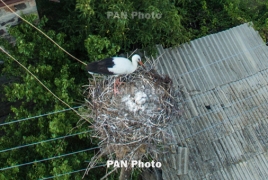The Smithsonian: Armenian villagers monitor storks' breeding process August 1, 2017 - 12:34 AMT PanARMENIAN.Net - The Smithsonian has published an article about the more than 650 pairs of breeding white storks who are hosted by Armenian villages each year, settling into numbered nests where they will hatch nestlings and teach the babies to feed. The storks—common in worldwide folklore for bringing babies to families—use Armenia as a stopover point to breed on their long journey south from western Europe to their winter grounds in Africa. At the same time, more than 1,000 families in those Armenian villages will take pen to paper and monitor the storks’ progress as part of a program called Nest Neighbors. The Smithsonian reveals the story of how Dr. Karen Aghababyan started the program in Armenia in 2006 as a nationwide survey of white storks, with the goal of tracking the health of the nearby wetland ecosystems. He and his team mapped every stork nest in the country, then—since white storks prefer nesting sights that are often near people, like on top of homes or electrical poles—they provided locals with questionnaires in the form of a calendar. The villagers write down important facts on the calendars and report information back to Aghababyan: the nest number they’re monitoring, what date the storks arrive, how many nestlings appear and if any incidents with the nest occur, such as it falling down. In 2007, the Nest Neighbors program received a Whitley Award, the top conservation award in the U.K., and continued to receive research funds from Whitley in 2010 and 2014. According to the publication, the Nest Neighbors program has made its way to schools as a model for environmental education. Also, the program led to changes in agricultural practices in local villages. The storks are also starting to attract a small number of tourists who stop to seeing the hundreds of nest-topped houses and swooping birds on their way to visit regional monasteries. Those who want to be honorary Nest Neighbors can tour the small villages near the Ararat Valley wetlands, including Surenavan and Hovtashat. The number of state universities will be reduced from 23 to 8 by 2030, Minister of Education, Science, Culture and Sport Zhanna Andreasyan has said. From September 21 to November 11, a total of 2,820 Russians registered at a place of residence in Armenia, the police has said. The situation on the contact line between Karabakh and Azerbaijan was relatively stable overnight, the Defense Army says. Defense Minister Suren Papikyan has visited the southern Armenian province of Syunik, the Defense Ministry reported on March 18. Partner news |